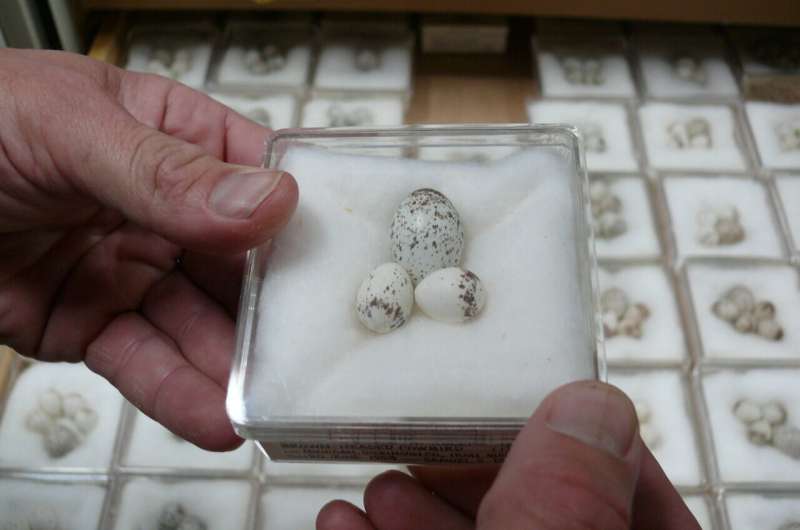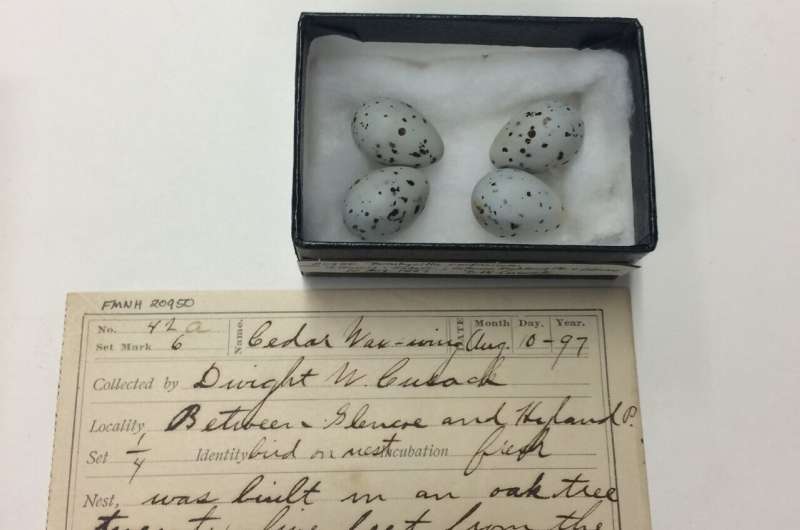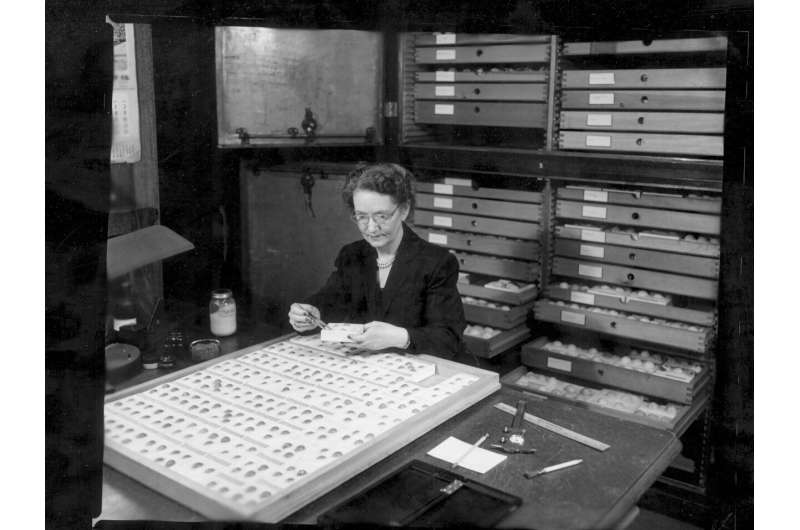A drawer from the Field Museum's egg collections. Credit: Bill Strausberger
Spring is in the air. Birds are singing and beginning to build their nests. It happens every year, like clockwork. But a new study in the Journal of Animal Ecology shows that many species of birds are nesting and laying eggs nearly a month earlier than they did a hundred years ago. By comparing recent observations with century-old eggs preserved in museum collections, scientists were able to determine that about a third of the bird species nesting in Chicago have moved their egg-laying up by an average of 25 days. And as far as the researchers can tell, the culprit in this shift is climate change.
"Egg collections are such a fascinating tool for us to learn about bird ecology over time," says John Bates, curator of birds at the Field Museum and the study's lead author. "I love the fact that this paper combines these older and modern datasets to look at these trends over about 120 years and help answer really critical questions about how climate change is affecting birds."
Bates got interested in studying the museum's egg collections after editing a book about eggs. "Once I got to know our egg collection, I got to thinking about how valuable that collection's data are, and how those data aren't replicated in modern collections," he says.
The egg collection itself occupies a small room crammed full with floor-to-ceiling cabinets, each containing hundreds of eggs, most of which were collected a century ago. The eggs themselves (or rather, just their clean, dry shells, with the contents blown out a hundred years ago) are stored in small boxes and accompanied by labels, often hand-written, saying what kind of bird they belong to, where they're from, and precisely when they were collected, down to the day.
"These early egg people were incredible natural historians, in order to do what they did. You really have to know the birds in order to go out and find the nests and do the collecting," says Bates. "They were very attuned to when the birds were starting to lay, and that leads to, in my opinion, very accurate dates for when the eggs were laid."
The Field's egg collection, like most, drops off after the 1920s when egg-collecting went out of fashion, both for amateur hobbyists and scientists. But Bates's colleague Bill Strausberger, a research associate at the Field, had worked for years on cowbird parasitism at the Morton Arboretum in the Chicago suburbs, climbing ladders and examining nests to see where Brown-headed Cowbirds had laid their eggs for other birds to raise. "He had to get out there every spring and find as many nests as he could and see whether or not they were parasitized, and so it occurred to me that he had modern nesting data," says Bates. Chris Whelan, an evolutionary ecologist at the University of Illinois at Chicago, also contributed to the modern dataset with songbird nesting data collected in Chicagoland starting in 1989 when he began work at the Morton Arboretum. Whelan and Strausberger's contributions to the study were critical, Bates says, because "finding nests is a lot harder than almost anybody realizes."
A clutch of Cedar Waxwing eggs in the Field Museum's collection from 1897. Credit: Field Museum
"Finding nests and following their fate to success or failure is extremely time-consuming and challenging," says Whelan. "We learned to recognize what I called 'nesty' behavior. This includes gathering nest material, like twigs, grass, roots, or bark, depending upon bird species, or capturing food like caterpillars but not consuming the food item—this likely indicates a parent is foraging to gather food for nestlings." Whelan and his team used mirrors mounted on long poles to peer into high-up nests and kept close track of the dates when eggs were laid and hatched.
The researchers then had two big sets of nesting data: one from roughly 1880-1920, and another from about 1990 to 2015. "There's a gap in the middle, and that's where Mason Fidino came in," says Bates. Fidino, a quantitative ecologist at Chicago's Lincoln Park Zoo and a co-author of the study, built models for analyzing the data that allowed them to address the gap in the middle of the 20th century, as well as the differences in sampling between early egg collectors and Whelan and Strausberger's research.
"Because of this uneven sampling, we had to share a little bit of information among species within our statistical model, which can help improve estimates a little bit for the rare species," says Fidino. "We all realized rather quickly that there may be some outliers present in the data, and if not accounted for, could have a rather large influence on the results. Because of this, we had to build our model to reduce the overall influence of any outliers, if they were present in the data."
The analyses showed a surprising trend: among the 72 species for which historical and modern data were available in the Chicagoland region, about a third have been nesting earlier and earlier. Among the birds whose nesting habits changed, they were laying their first eggs 25.1 days earlier than they were a hundred years ago.
In addition to illustrating that birds are laying eggs earlier, the researchers looked for a reason why. Given that the climate crisis has dramatically affected so many aspects of biology, the researchers looked to rising temperatures as a potential explanation for the earlier nesting. But the scientists hit another snag: there aren't consistent temperature data for the region going back that far. So, they turned to a proxy for temperature: the amount of carbon dioxide in the atmosphere.
"We couldn't find a single source of long-term temperature data for the Midwest, which was surprising, but you can approximate temperature with carbon dioxide levels, which are very well documented," says Bates. The carbon dioxide data comes from a variety of sources, including the chemical composition of ice cores from glaciers.
Ann McLellan Bigelow working in the Field Museum's egg collections in 1951. Credit: John Bayalis, Field Museum
The amount of carbon dioxide in the atmosphere over time neatly maps onto larger temperature trends, and the researchers found that it also correlated with the changes in egg-laying dates. "Global climate change has not been linear over this nearly 150-year period, and therefore species may not have advanced their lay date in non-linearly as well. Therefore, we included both linear and non-linear trends within our model," says Fidino. "We found that the simulated data was very similar to the observed data, which indicated that our model did a decent job."
The changes in temperature are seemingly small, just a few degrees, but these little changes translate to different plants blooming and insects emerging— things that could affect the food available for birds.
"The majority of the birds we looked at eat insects, and insects' seasonal behavior is also affected by climate. The birds have to move their egg-laying dates to adapt," says Bates.
And while birds laying their eggs a few weeks early might seem like a small matter in the grand scheme of things, Bates notes that it's part of a larger story. "The birds in our study area, upwards of 150 species, all have different evolutionary histories and different breeding biology so it's all about the details. These changes in nesting dates might result in them competing for food and resources in a way that they didn't used to," he says. "There are all kinds of really important nuances that we need to know about in terms of how animals are responding to climate change."
In addition to serving as a warning about climate change, Bates says the study highlights the importance of museum collections, particularly egg collections, which are often under-utilized. "There are 5 million eggs out there in collections worldwide, and yet, they're very few publications using museum collections of eggs," says Bates. "They're a treasure trove of data about the past, and they can help us answer important questions about our world today."
More information: Climate Change Affects Bird Nesting Phenology: Comparing Contemporary Field and Historical Museum Nesting Records, Journal of Animal Ecology (2022). DOI: 10.1111/1365-2656.1368
Journal information: Journal of Animal Ecology
Provided by Field Museum


























